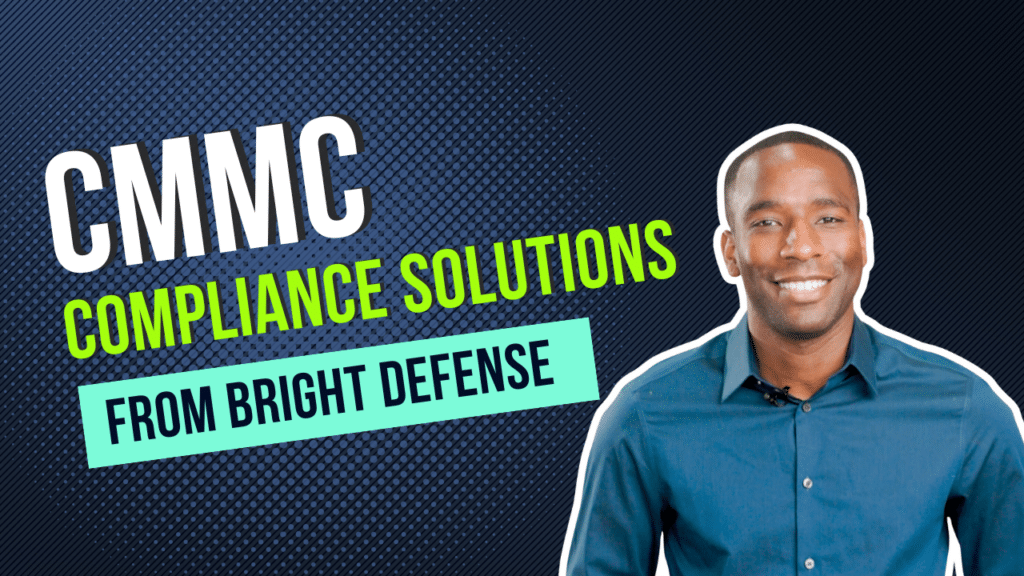
John Minnix
February 26, 2025
Continuous Compliance – The Ultimate Guide
Continuous compliance is rapidly becoming standard practice for cybersecurity. 91% of organizations plan to implement continuous compliance in the next five years, according to Drata. Continuous compliance ensures businesses perpetually align with security and regulatory standards, lowering the risk of a security breach and eliminating the scramble to prepare for traditional annual audits.
In this blog, we will:
- Define continuous compliance and outline its benefits.
- Contrast continuous compliance with the traditional compliance model.
- Review the key components of a successful continuous compliance strategy.
- Discuss how you can implement continuous compliance in your organization and how Bright Defense can help.
Let’s get started!
What is Continuous Compliance?
Continuous compliance is a proactive methodology that stresses ongoing alignment with set regulatory guidelines and security protocols. It moves away from the traditional scheduled audit model and towards real-time oversight and immediate response mechanisms. It aims to reduce risks and bolster an organization’s security posture.
Continuous compliance is an answer to legacy periodic compliance or point-in-time compliance models. With periodic compliance, organizations assess their compliance status at specific intervals, such as annually or biannually, rather than maintaining a continuous, real-time oversight. It’s a more reactive approach, typically relying on scheduled audits to identify and rectify compliance gaps or deviations, as opposed to the proactive, ongoing monitoring emphasized by continuous compliance.

Continuous vs. Periodic Compliance: A Deep Dive
Continuous compliance differs from periodic compliance in monitoring frequency, adaptability to change, response time deviations, and more. Let’s explore these factors more.
Monitoring Frequency
Continuous compliance ensures a regular and consistent watch over operations. With its emphasis on ongoing oversight, deviations are detected and addressed as they occur. Automated tools and real-time data keep the organization constantly aligned with standards, eliminating the need for last-minute preparations come audit time. This uninterrupted approach reduces the chances of “audit surprises,” making the process smoother and more predictable.
Organizations relying on periodic compliance conduct checks at specific intervals, such as monthly, quarterly, or yearly. While this method seems structured, it introduces risks, especially in rapidly changing environments. There’s potential for discrepancies to go unnoticed between scheduled audits. As the audit date nears, there’s often a rush to ensure compliance, leading to spikes in resource utilization and possible oversight errors.
When determining the proper monitoring approach, the speed of detection and response plays a key role. Whilecontinuous compliance monitoring offers the advantage of real-time oversight, periodic compliance can sometimes lag, especially in fast-paced industries or environments.

Resource Allocation
In the continuous compliance model, resource allocation is steady and predictable. Instead of periodic scrambles, there’s constant monitoring and adjustment to ensure adherence to standards. This ongoing approach means that there’s no last-minute rush or extra resource allocation when audit time arrives.
Teams can function regularly, avoiding the stress of audit-induced work spikes. Additionally, with real-time monitoring tools, much of the compliance workload is automated, freeing up personnel to focus on other core activities.
Periodic compliance, on the other hand, often sees significant fluctuations in resource needs. As audit dates loom, there’s a spike in human and financial resources. Teams might work overtime, consultants could be brought in, and extra tools or systems might be temporarily employed to ensure everything is audit-ready. These resource utilization peaks strain budgets and can disrupt regular operations and lead to employee burnout.
When considering resource allocation, organizations must evaluate the direct costs and indirect impacts on operational efficiency, employee well-being, and overall business agility. Continuous compliance offers a more balanced and sustainable approach, while periodic compliance presents challenges in predictability and management.

Culture
Adopting continuous compliance cultivates a proactive culture within organizations. It shifts the mindset from sporadic compliance checkups to a daily commitment to maintaining standards. This ongoing dedication not only boosts internal confidence but also assures external stakeholders, such as customers and partners, of the organization’s unwavering commitment to security and regulatory adherence.
Consistent compliance actions and communications become embedded in daily operations, fostering trust and transparency. Stakeholders can be more assured that the organization is always audit-ready, reducing concerns about potential compliance lapses or breaches.
With periodic compliance, the culture is more reactive. Emphasis is on meeting standards primarily around audit times, which can create a cyclic pattern of urgency followed by complacency. This intermittent focus can sometimes send mixed signals. While there might be strong reassurances during audit periods, gaps in communication or visibility during off-peak times can lead to questions about the organization’s steadfast commitment to security.
The chosen compliance approach plays a significant role in molding an organization’s culture and mindset. Continuous compliance encourages a more ingrained and holistic commitment to standards, promoting trust among all stakeholders. In contrast, the sporadic focus of periodic compliance can make stakeholder assurance more challenging to maintain consistently.

Technology and Automation
In a continuous compliance framework, technology is seamlessly integrated into daily operations. Automated monitoring tools, real-time analytics, and alert systems work hand in hand to maintain a persistent oversight. This consistent tech integration allows for immediate responses to deviations, leveraging the latest cybersecurity and regulatory software advancements.
The technology stack in continuous compliance is about detection and adaptability, enabling organizations to swiftly align with evolving regulatory landscapes or emerging threats. As a result, technology is viewed as an enabler, driving efficiency and ensuring sustained adherence to standards.
Technology integration often occurs in phases for organizations operating under periodic, internal compliance audits, typically ramping up closer to audit dates. While they might employ advanced tools, the utilization tends to be more sporadic, focusing on short-term audit readiness rather than long-term security and compliance vision. This intermittent integration can sometimes result in gaps, where outdated systems or tools might be used in non-audit periods, potentially leaving vulnerabilities unaddressed. Furthermore, the technology might be considered a requirement to “pass the test” rather than a continuous ally in upholding standards.
While continuous compliance leverages technology as a constant partner in ensuring security and adherence, periodic compliance might risk underutilizing tech’s full potential, treating it as an occasional aid rather than an integrated asset.

Cost Implications
Continuous compliance makes the cost structure more predictable and evenly spread over time. Investments are made in managed services, real-time monitoring tools, automated systems, and regular training sessions. While there might be an initial setup or transition cost, the overall expenditure tends to stabilize as the system matures.
In the long run, potential savings arise from avoiding hefty non-compliance fines, reducing resource surges around audit times, and minimizing the impacts of breaches due to early detection. Continuous compliance is often an ongoing operational expense that offers security and financial predictability.
Periodic compliance, conversely, often presents a more fluctuating cost pattern. While expenses might be reduced during non-audit periods, costs typically spike as audit dates approach. This surge can come from hiring consultants, deploying temporary tools, or incurring overtime charges.
Additionally, the risk of undetected non-compliance or security breaches during the gaps between audits could lead to significant unplanned expenses in the form of fines or mitigation efforts. The intermittent nature of these costs can make budgeting challenging and introduce financial uncertainties.
In assessing the cost implications, organizations must look beyond the immediate expenses and consider the long-term financial impact. Continuous compliance offers a more consistent expenditure pattern and potential savings from proactive measures, while periodic compliance can introduce cost variability and potential risk-associated expenses.

Achieving Continuous Compliance in Your Organization
Let’s review the basic steps for how your organization can achieve continuous compliance.
Assessing Current Compliance Processes and Identifying Gaps
To transition to continuous compliance, start by evaluating your current compliance procedures. Understand where you currently stand by conducting a thorough assessment.
Document all existing processes, controls, and tools. Once documented, perform a gap analysis to identify areas lacking continuous monitoring or outdated regarding best practices or regulatory requirements. Remember, recognizing vulnerabilities is the first step to strengthening your compliance posture.
Choosing the Right Tools and Technologies
The backbone of continuous compliance is the technology that supports it. As compliance requirements evolve, so should your tools. When selecting tools, prioritize those that offer real-time monitoring capabilities, automation features, and scalability to grow with your needs.
Consider solutions that integrate seamlessly with your existing systems and adapt to emerging regulations. Cloud-based solutions, advanced analytics, and artificial intelligence can further enhance the efficiency and accuracy of your compliance endeavors. Popular compliance automation platforms include Vanta, Drata, and Carbide.

Training and Cultural Shift: Fostering a Continuous Compliance Mindset Among Employees
Continuous compliance isn’t just a set of tools or protocols—it’s a mindset. And for it to be effective, this mindset needs to be embraced organization-wide. Conduct regular security awareness training sessions for employees, ensuring they know the latest compliance requirements and their role in maintaining them. Incorporate practical exercises like phishing tests to evaluate and enhance employees’ awareness and responsiveness to potential security threats.
Reinforce the importance of daily compliance rather than viewing it as a periodic task. Recognize and reward those who actively contribute to a compliant culture and openly discuss the benefits of continuous compliance monitoring, to drive engagement and dedication.
Regularly Reviewing and Updating Policies
Your policies and procedures should never be static for continuous compliance to remain effective. The regulatory landscape is constantly changing, and compliance standards vary, and your organization must adapt. Schedule regular reviews of your compliance policies, ensuring they align with current regulations and industry best practices. Additionally, seek feedback from various departments, as they may offer insights into challenges or potential improvements. As updates are made, communicate these changes clearly to all stakeholders and ensure they have the necessary tools and training to adhere to the new standards.
Implementing continuous compliance is a commitment to operational excellence, security, and adaptability. By following these steps, organizations can position themselves as leaders in regulatory adherence and cybersecurity, instilling trust among their partners, clients, and employees.

Conclusion
In today’s compliance landscape, relying solely on periodic checks for compliance can leave organizations vulnerable and ill-prepared. Continuous compliance emerges as a proactive, adaptive, and robust approach. It ensures that businesses remain ahead of potential threats and always align with regulatory standards.
By shifting from a reactive to a proactive mindset, companies safeguard their operations and instill greater confidence among partners, stakeholders, and customers. Embracing continuous compliance means investing in technology, training, and culture — but the returns, both in security and reputation, are invaluable. As regulations continue to evolve and the digital realm becomes even more intricate, the importance of a steadfast commitment to continuous compliance will only grow.
Bright Defense is Your Continuous Cybersecurity Compliance Partner
Are you ready to achieve continuous compliance? Bright Defense can help. Our mission is to defend the world from cybersecurity threats through continuous compliance. We help you improve your security posture to help mitigate the risk of a data breach.
With our monthly service offering, our CISSP and CISA-certified security experts will develop and execute a cybersecurity plan to meet compliance standards, including SOC 2, CMMC, HIPAA, ISO 27001, and NIST. Our service includes:
- Gap analysis
- Risk assessment and risk management
- Generation and implementation of security policies
- Business continuity planning
- Certification assistance
We also include our managed compliance automation platform, security awareness training, phishing testing, and vCISO services.
Get started today with Bright Defense!

FAQ: Continuous Compliance Explained
What is the difference between the compliance process in periodic and continuous approaches?
Periodic audits typically focus on reviewing and maintaining compliance with standards at specified intervals, such as an annual audit. In contrast, continuous compliance is an ongoing process where businesses continuously monitor and maintain compliance, addressing any compliance issues in real-time.
How can continuous compliance help identify security gaps?
Continuous compliance offers real-time visibility into security practices and controls. This proactive approach allows for immediate risk detection, ensuring that security gaps are identified and addressed promptly, rather than waiting for scheduled internal audits or third-party compliance audits.
Does continuous compliance replace my annual audit?
No, continuous compliance complements annual or periodic audits. While you’ll still undergo compliance audits, the process becomes smoother as potential issues have already been addressed. This often results in fewer surprises during the audit, thanks to the ongoing compliance efforts.
How does continuous compliance fit into a cloud infrastructure?
Cloud infrastructures often house data across multiple frameworks and regions. Continuous compliance ensures that all areas of the cloud infrastructure adhere to internal policies and compliance standards consistently, providing an added layer of security controls.
What are the key benefits of continuous compliance?
The benefits of continuous compliance include rapid risk detection, reduced chances of non-compliance penalties, and maintaining a competitive advantage for business in today’s dynamic business environment. Additionally, it fosters trust among third-party vendors and stakeholders, as they recognize the business’s commitment to stringent security practices.
How can businesses manage achieving compliance across different regulatory standards?
Continuous compliance management tools often support multiple frameworks, allowing businesses to seamlessly align with various standards. This ensures that even if a business operates under multiple regulations, it can maintain compliance effectively and efficiently.
How does continuous compliance support internal rules?
Beyond aligning with external regulations, businesses often have internal rules to uphold their standards. Continuous compliance ensures that these internal rules are consistently met, further enhancing the security and integrity of the organization.
Is it a challenge to implement continuous compliance in established businesses?
While introducing any new system can have its challenges, the long-term benefits outweigh initial setup efforts. Businesses can close compliance gaps by integrating continuous monitoring tools, training staff, and adopting a proactive approach to compliance, making it an integral part of daily operations.
How do third-party vendors fit into the continuous compliance picture?
Third-party vendors can introduce potential risks. Continuous compliance helps monitor and ensure that these vendors also adhere to the necessary compliance standards, reducing potential vulnerabilities.
Get In Touch



